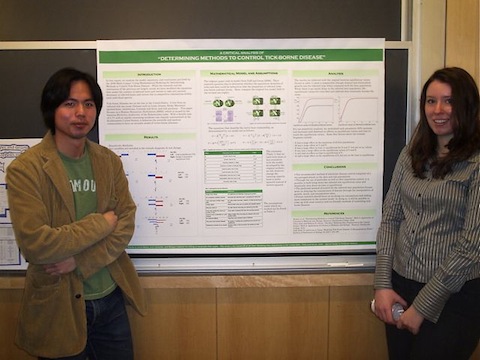2010 Mathematical Biology Student Poster Session
Tuesday March 9 2010, 10:30 AM, Kemeny 006
Yaa Obeng-Aduasare and Afia Owusu Obeng
Modeling Optimal Structured Treatment Interruptions with Discrete Time periods or as a function of individual T-Cell viral loads
Abstract: The guidelines for the administering of anti-retroviral drugs continue to be a point of contention. In areas where, access to these life-saving drugs is scant, a need arises for formulating cost-effective regimens that consider the limitations as well as the negative effects of anti-retroviral drugs. One such regimen incorporates structured treatment interruptions (STIs), where "patients are cycled on and off [drug] therapy." This paper considers the established STI periods at both distinct period and also as a function of a patient's T-cell count at any given time using a mathematical model that attempts to model the interaction of different immune players in the presence of two classes of antiretroviral; reverse-transcriptase inhibitors and protease inhibitors. Given that at each replication cycle, the Human Immunodeficiency Virus makes multiple mistakes in its genome. We argue that the second technique of determining the optimal STI periods may be an effective model because the increase in viral load should correlate with a gradual resistance of the virus. Thus, taking a patient off the drug regimen should coincide with this resistance period, when there is an increase in viral load. We expect that this increase in viral load triggers the up-regulation of CD8 immune effector cell recruiting, inducing the clearance of infected T-cells.
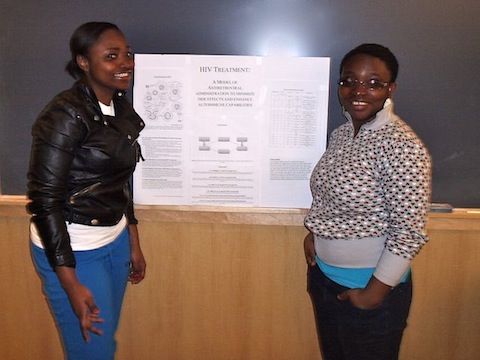
Jenny Zhao and Alyssa Coleman
Malaria Vaccination
The basic model of the mathematical study of malaria transmission dynamics will be extended to incorporate an ideal, perfectly effective malaria vaccine. To do so, a new variable will be introduced for the populations of vaccinated individuals in addition to the susceptible number of individuals already present in the model. A sensitivity analysis of tornado diagrams will be performed to examine the importance of the death rate and birth rate of humans and vectors, the vaccination rate, as well as other parameters present in the original model.
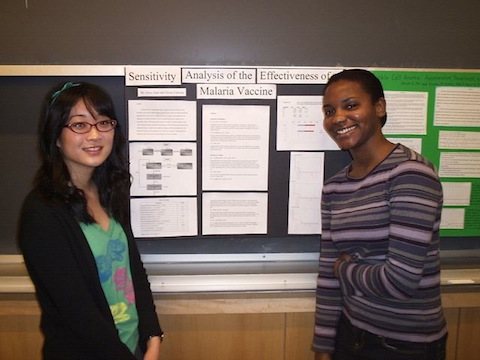
Martin Kulander and Dan Sotsky
Ebola in Hanover?
Beginning with the initial outbreak of 1976, Ebola hemorrhagic fever has been a recurring public health concern in sub-Saharan Africa. In spite of advanced control mechanisms, Ebola presents a significant risk for human populations both in sub-Saharan Africa due to its high infection rate and high overall mortality. The 2004 paper "The basic reproductive number of Ebola and the effects of public health measures: the cases of Congo and Uganda" by Chowell, et al, models Ebola outbreaks from 2000 and 1995. Evaluating this study, we performed a sensitivity analysis of the constants generated in their model of the aforementioned outbreaks. Considering this data, we modeled a potential outbreak of Ebola in Hanover, NH, analyzing the effect of control measures and their timing on the overall course of the outbreak.
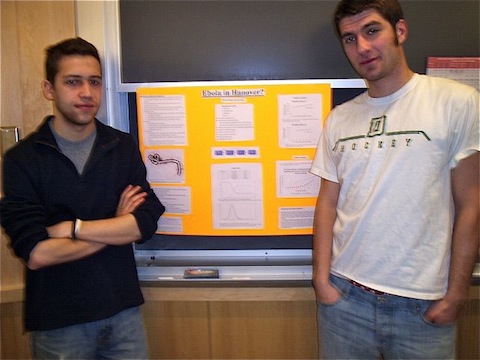
Michelle Evans and Amy Van Scoyoc
SARS at the Olympics
In 2003, a global epidemic of Severe Acute Respiratory Syndrome (SARS) infected over 8000 people worldwide and lead to 774 deaths. The epidemic was especially devastating in China, where the virus originated, killing at least 289 people. However, classic SIR (Susceptible-Infected-Recovered) models failed to accurately match the actual data from the epidemic, predicting higher numbers of people infected with SARS than actually occurred. This lead to the conclusion that the number of people susceptible to the virus was smaller than the actual population, as is the case when a population is vaccinated against a disease. A double epidemic model, where two overlapping epidemics (SARS and virus B) occurred simultaneously, was thus proposed to explain the propagation of SARS. This model is based on the hypothesis that virus B is highly infections, relatively innocuous (something similar to a stomach bug) and highly related to SARS, thus conferring immunity to SARS if one is infected with virus B first. Although the global epidemic of SARS ended in 2003, the 2008 Summer Olympics in Beijing could have led to another worldwide epidemic had a SARS outbreak occurred. Using the double epidemic model for the propagation of SARS, we explore how many of the 389,000 tourists in Beijing during the month of the Olympics would have contracted SARS, how many Americans and Japanese would have contracted the disease, and how the epidemic would spread in the US and Japan if both people infected with SARS and people infected with virus B returned home.

Nicole Johns and Sam Rauch
Despite its existence among human populations for more than 3,000 years, malaria remains one of the most prevalent diseases in several regions of the world and one of the top ten causes of death worldwide. No effective vaccine yet exists, and drugs that are available are used infrequently and often improperly (The WHO puts the percentage of promptly and effectively treated children at a mere 3% ). Thus, novel approaches to disease eradication must be pursued, such as a vaccine administered to humans that could kill the malaria parasite in mosquitos. The existing model of human and mosquito populations in Cameroon proposed by Teboh-Ewungkem was further explored to assess the theoretical impact of introducing such an intervention.
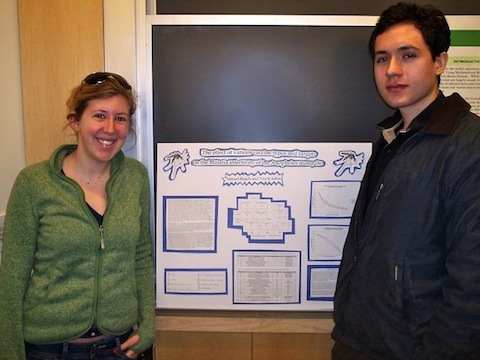
Rukayat Ariganjoye and Bekey (Soye) Lee
Gonorrhea-induced infertility: Using differential equations to model population depression of Yap in 1930
Gonorrhea-induced infertility can significantly impact population growth. In 1930, Yap population declined drastically, a phenomenon caused by a high death rate triggered by tuberculosis coupled with low fertility induced by gonorrhea. This paper will study the effects of gonorrhea-induced infertility in Yap population during the Japanese occupation in 1930. It will apply statistical data from Yap population and visualize it using a number of differential equations that will take into account various contact patterns to determine infection and ultimately decline in population growth. Furthermore, it will compare different models used to study population depressions, namely the simulation model (Cassels) and the differential equation box model (Garnett et al.) to determine which better reflects and can predict population depression caused by gonorrhea-induced infertility.

Additional posters:


